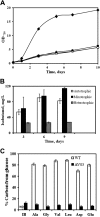Metabolic engineering of Synechocystis sp. strain PCC 6803 for isobutanol production
- PMID: 23183979
- PMCID: PMC3568544
- DOI: 10.1128/AEM.02827-12
Metabolic engineering of Synechocystis sp. strain PCC 6803 for isobutanol production
Abstract
Global warming and decreasing fossil fuel reserves have prompted great interest in the synthesis of advanced biofuels from renewable resources. In an effort to address these concerns, we performed metabolic engineering of the cyanobacterium Synechocystis sp. strain PCC 6803 to develop a strain that can synthesize isobutanol under both autotrophic and mixotrophic conditions. With the expression of two heterologous genes from the Ehrlich pathway, the engineered strain can accumulate 90 mg/liter of isobutanol from 50 mM bicarbonate in a gas-tight shaking flask. The strain does not require any inducer (i.e., isopropyl β-d-1-thiogalactopyranoside [IPTG]) or antibiotics to maintain its isobutanol production. In the presence of glucose, isobutanol synthesis is only moderately promoted (titer = 114 mg/liter). Based on isotopomer analysis, we found that, compared to the wild-type strain, the mutant significantly reduced its glucose utilization and mainly employed autotrophic metabolism for biomass growth and isobutanol production. Since isobutanol is toxic to the cells and may also be degraded photochemically by hydroxyl radicals during the cultivation process, we employed in situ removal of the isobutanol using oleyl alcohol as a solvent trap. This resulted in a final net concentration of 298 mg/liter of isobutanol under mixotrophic culture conditions.
Figures




Similar articles
-
Light-induced production of isobutanol and 3-methyl-1-butanol by metabolically engineered cyanobacteria.Microb Cell Fact. 2022 Jan 6;21(1):7. doi: 10.1186/s12934-021-01732-x. Microb Cell Fact. 2022. PMID: 34991586 Free PMC article.
-
Expressing 2-keto acid pathway enzymes significantly increases photosynthetic isobutanol production.Microb Cell Fact. 2022 Feb 1;21(1):17. doi: 10.1186/s12934-022-01738-z. Microb Cell Fact. 2022. PMID: 35105340 Free PMC article.
-
Employment of light-inducible promoter in genetically engineered cyanobacteria for photosynthetic isobutanol production with simulated diurnal sunlight and CO2.J Biotechnol. 2024 Sep 20;393:31-40. doi: 10.1016/j.jbiotec.2024.07.014. Epub 2024 Jul 22. J Biotechnol. 2024. PMID: 39047910
-
Metabolic engineering of Escherichia coli for the production of isobutanol: a review.World J Microbiol Biotechnol. 2021 Sep 6;37(10):168. doi: 10.1007/s11274-021-03140-0. World J Microbiol Biotechnol. 2021. PMID: 34487256 Review.
-
Frontiers in microbial 1-butanol and isobutanol production.FEMS Microbiol Lett. 2016 Mar;363(5):fnw020. doi: 10.1093/femsle/fnw020. Epub 2016 Jan 31. FEMS Microbiol Lett. 2016. PMID: 26832641 Review.
Cited by
-
Identification of alcohol stress tolerance genes of Synechocystis sp. PCC 6803 using adaptive laboratory evolution.Biotechnol Biofuels. 2017 Dec 20;10:307. doi: 10.1186/s13068-017-0996-5. eCollection 2017. Biotechnol Biofuels. 2017. PMID: 29270221 Free PMC article.
-
Quantitative proteomics analysis of an ethanol- and a lactate-producing mutant strain of Synechocystis sp. PCC6803.Biotechnol Biofuels. 2015 Aug 5;8:111. doi: 10.1186/s13068-015-0294-z. eCollection 2015. Biotechnol Biofuels. 2015. PMID: 26246854 Free PMC article.
-
Insights into isoprene production using the cyanobacterium Synechocystis sp. PCC 6803.Biotechnol Biofuels. 2016 Apr 18;9:89. doi: 10.1186/s13068-016-0503-4. eCollection 2016. Biotechnol Biofuels. 2016. PMID: 27096007 Free PMC article.
-
Recent advances in metabolic engineering of microorganisms for advancing lignocellulose-derived biofuels.Bioengineered. 2022 Apr;13(4):8135-8163. doi: 10.1080/21655979.2022.2051856. Bioengineered. 2022. PMID: 35297313 Free PMC article. Review.
-
Light-induced production of isobutanol and 3-methyl-1-butanol by metabolically engineered cyanobacteria.Microb Cell Fact. 2022 Jan 6;21(1):7. doi: 10.1186/s12934-021-01732-x. Microb Cell Fact. 2022. PMID: 34991586 Free PMC article.
References
-
- Rittmann BE. 2008. Opportunities for renewable bioenergy using microorganisms. Biotechnol. Bioeng. 100:203–212 - PubMed
-
- van Groenigen KJ, Osenberg CW, Hungate BA. 2011. Increased soil emissions of potent greenhouse gases under increased atmospheric CO2. Nature 475:214–216 - PubMed
-
- Keasling JD, Chou H. 2008. Metabolic engineering delivers next-generation biofuels. Nat. Biotechnol. 26:298–299 - PubMed
-
- Atsumi S, Hanai T, Liao JC. 2008. Non-fermentative pathways for synthesis of branched-chain higher alcohols as biofuels. Nature 451:86–89 - PubMed
Publication types
MeSH terms
Substances
LinkOut - more resources
Full Text Sources
Other Literature Sources

